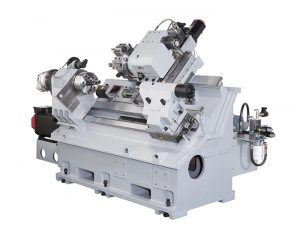Give Us a Call 586-755-1234
Give Us a Call 586-755-1234
MACHINING CENTERS
A 3-Axis CNC Machining Center/Mill is used for creating various industrial parts. This is achieved by using a wide-range of tooling and cutters depending on the type of material being cut and the end product being manufactured.

A 3-axis CNC Mill works on three separate axes:
CNC Vertical Mills generally have a single spindle, automatic tool changer, work table and CNC Control.
The spindle on a CNC Machining Center can have a wide range of speeds depending on what material is being cut and the depth of cut that is required. Typical spindle speed ranges from 0 to 10,000 RPM. Higher speeds are used for lighter materials including graphite and aluminum among others. Higher speeds can reach 12,000 RPM up to 50,000 RPM and higher.
The Spindle is loaded with tool holders and cutters to achieve the proper material removal. There are many different styles of tool holders including BT and CAT – which have a conical shape as well as HSK, which uses flanges instead of a taper to lock the holder in place. BT and CAT Holders can come in various sizes including 30, 40 and 50 taper depending on the size of tool the cutter requires. HSK (Hollow taper ShanK) comes in a variety of types – A through F – and sizes from HSK-32 up to HSK-160. HSK is considered a better tool holder for high speed machining as there is more surface contact between the spindle and the holder, reducing vibration and keeping the tool from pulling back into the receiver when cutting at high speeds.
A CNC Vertical Machining Center offers different styles of automatic tool changers as well. The most common style is the umbrella-style. This is where the tool holders are loaded into the carousel vertically. The other style is a drum or side-mount style. The tools are loaded in horizontally in this type. This allows for greater part height in the work area and can help accommodate a rotary table, fixture or any additional work holding devices mounted to the table.
CNC Vertical Mills are manufactured by a wide-range of companies including Haas, Fadal, Okuma, Mazak, OKK, Milltronics, Doosan, Daewoo, Samsung, Supermax, YCM, Takumi, Hurco, Leadwell, Johnford and more. Different manufacturers focus on different types of machining, from light duty finishing to heavy duty material removal. While some manufacturers have proprietary CNC Controls (such as Hurco, Mazak and Okuma) others use more industry-wide CNC Controls such as Fanuc or Mitsubishi.
 CNC Vertical Machining Centers can include an additional axis to do specific cutting applications. Rotary Tables are common as a 4th Axis on mills. They can vary in size and weight capacities and can have a horizontal or vertical configuration. They are generally an add-on to a standard 3-axis mill. The mill will have to have a proper 4th axis interface (generally a 4th axis card, drive and CNC Control) to accept a 4th axis rotary table.
CNC Vertical Machining Centers can include an additional axis to do specific cutting applications. Rotary Tables are common as a 4th Axis on mills. They can vary in size and weight capacities and can have a horizontal or vertical configuration. They are generally an add-on to a standard 3-axis mill. The mill will have to have a proper 4th axis interface (generally a 4th axis card, drive and CNC Control) to accept a 4th axis rotary table.
Trunnion Tables can also be an add-on to a vertical CNC Mill. A Trunnion table adds a 4th and 5th axis to a standard mill by incorporating an A-Axis (which rotates around the X-Axis) as well as a C-Axis (which rotates around the Z Axis).
A true 5-axis machine can allow for continuous 5-axis machining simultaneously. This increases both speed and accuracy when machining the part.
The type of CNC Vertical Mill allows for long and/or heavy parts to be machined is known as a Gantry, Bridge Style or Double Column Machining Center. Typically the part is mounted on a table which will move on the X-Axis while the Spindle is mounted to the Bridge which moves the spindle along the Y and Z axis. The Bridge is considered “fixed” meaning the part is moved on the table while the bridge stays stationary and controls only the Y and Z Axis.
A Gantry-Style CNC Mill allows for the part to stay stationary while the gantry moves around it on all 3 axes to accomplish the finished part. The gantry moves all 3 axes – X, Y, Z – around the part on a fixed table.
Some of these larger machines offer options such as multiple-heads, full 5-axis machining, geared-head spindles, as well as more common options such as spindle speeds, spindle taper, tool capacity, etc.
Drill and Tapping Machines are used for small, high-speed, production-style machining. They generally have a small footprint, high cut and feed rates and can be placed in small cells to accommodate one operator running multiple machines at once.
CNC Drill & Tapping Machines have high-speed tool changers to save valuable machining time and usually have smaller spindle tapers as these machines do smaller, lighter machining. Many times you will see fixtures incorporated on to the work table for multiple parts to be machined in one setup. Indexers or rotary tables can also be used to avoid multiple setups.
CNC Drill & Tap Machines can also feature either a single work table or rotary pallet indexers where an operator can load parts on the outside of the work area while machining is done on the inside of the machine. These pallet indexers increase productivity and keep a continual cycle of parts coming in and out of the machine.